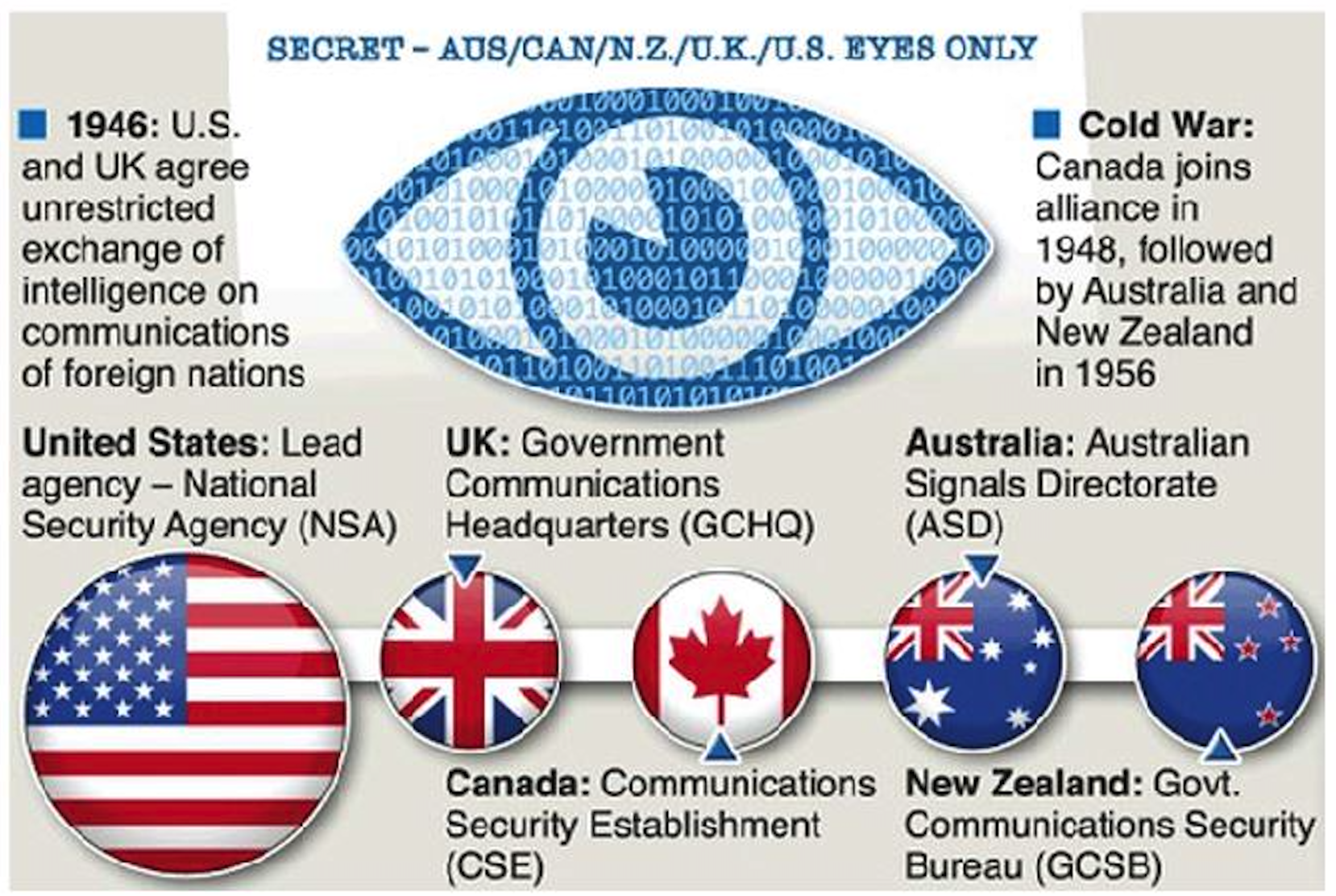Five Eyes Intelligence-sharing Network

- 03 May 2024
Why is it in the News?
Recently, the Australian Broadcasting Corporation (ABC) reported that “Indian spies” had been “kicked out of Australia” after being caught trying to steal secrets about sensitive defence projects and airport security, as well as classified information on Australia’s trade relationships”.
What is the Five Eyes?
- The Five Eyes is an intelligence alliance comprising Australia, Canada, New Zealand, the United Kingdom and the United States, formed in 1946.
- The alliance is based on a series of bilateral agreements on surveillance and intelligence-sharing.
- These arrangements are commonly known as the United Kingdom-United States Communication Intelligence Act (UKUSA) agreement.
- The UKUSA agreement is a secret pact that, since 1946, has allowed the two countries to share intelligence with each other.
- The UKUSA agreement was so secret that its existence wasn't even acknowledged until 2005.
- Each of the Five Eyes states pursues interception, collection, and decryption activities and shares all intelligence information obtained with the others by default.
- These countries share information with each other through the ultra-sensitive STONEGHOST network, which has been claimed to contain "some of the Western world's most closely guarded secrets".
- The Five Eyes states share integrated programmes, staff, and bases.
Origins of the Five Eyes
- During World War II, informal secret meetings between British and American code-breakers laid the groundwork for establishing the FE alliance.
- After the Cold War, the information-sharing arrangement became formalised under the ECHELON surveillance system in the 1960s.
How does the Five Eyes Alliance operate?
- The alliance facilitates the sharing of signals intelligence among the five countries.
- The countries agree to exchange by default all signals intelligence they gather.
- The bedrock of the Five Eyes Alliance is based on the joint abilities of the United Kingdom's Government Communications Headquarters (GCHQ) and the USA's National Security Agency (NSA) to intercept intelligence.
- These agencies collect and decrypt signal intelligence, called SigInt, which involves internet, telephone, radio and satellite data from across the world.
- The UKUSA Agreement, which was made public in 2010, states:
- "It will be contrary to this agreement to reveal its existence to any third party whatsoever" and "each party will seek the agreement of the other to any action with third parties and will take no action until its advisability is agreed upon."
Five Eyes’ Intelligence Alliance (The Hindu)
- 29 Sep 2023
What is the News ?
The recent claims made by Canadian Prime Minister Justin Trudeau, connecting the murder of Hardeep Singh Nijjar on Canadian territory to the Indian government, have drawn attention to the intelligence-sharing coalition known as the 'Five Eyes' (FVEY).
Facts About:
- This multilateral intelligence-sharing network involves more than 20 agencies from five predominantly English-speaking nations:
Australia, Canada, New Zealand, the United Kingdom, and the United States.
- It encompasses both surveillance-based activities and signals intelligence (SIGINT).
- The intelligence documents shared among member countries are labeled as 'Secret—AUS/CAN/NZ/UK/US Eyes Only,' which gives rise to the group's name, 'Five Eyes.'
Background of the Alliance:
- The origins of this alliance between the U.S. and the U.K. date back to the Second World War when they collaborated to counter the Cold War Soviet threat.
- These two nations, renowned for their code-breaking achievements during World War II, established cooperation in sharing intelligence related to various forms of signals, including radio, satellite, and internet communications.
- Following the war, in 1946, the alliance formalized through an agreement focused on signals intelligence.
This agreement, originally named the British-U.S. Communication Intelligence Agreement (BRUSA) and now known as the UKUSA Agreement, was signed between the U.S. State-Army-Navy Communication Intelligence Board (STANCIB) and the British London Signal Intelligence Board (SIGINT).
- Initially, its scope was limited to 'communication intelligence matters only,' involving the unrestricted exchange of intelligence products across six areas: traffic collection, acquisition of communication documents and equipment, traffic analysis, cryptanalysis, decryption and translation, and the acquisition of information regarding communication organizations, practices, procedures, and equipment.
- Over time, the alliance expanded to include 'second party' countries, with Canada joining in 1948, and Australia and New Zealand becoming part of the alliance in 1956.
